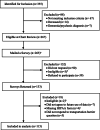Transportation as a barrier to colorectal cancer care
- PMID: 33849524
- PMCID: PMC8045363
- DOI: 10.1186/s12913-021-06339-x
Transportation as a barrier to colorectal cancer care
Abstract
Background: Transportation barriers limit access to cancer care services and contribute to suboptimal clinical outcomes. Our objectives were to describe the frequency of Veterans reporting and the factors associated with transportation barriers to or from colorectal cancer (CRC) care visits.
Methods: Between November 2015 and September 2016, Veterans with incident stage I, II, or III CRC completed a mailed survey to assess perceived barriers to recommended care. Participants who reported difficulty with transportation to or from CRC care appointments were categorized as experiencing transportation barriers. We assessed pairwise correlations between transportation barriers, transportation-related factors (e.g., mode of travel), and chaotic lifestyle (e.g., predictability of schedules), and used logistic regression to examine the association between the reporting of transportation difficulties, distance traveled to the nearest Veterans Affairs (VA) facility, and life chaos.
Results: Of the 115 Veterans included in this analysis, 18% reported experiencing transportation barriers. Distance to the VA was not strongly correlated with the reporting of transportation barriers (Spearman's ρ = 0.12, p = 0.19), but chaotic lifestyle was both positively and significantly correlated with experiencing transportation barriers (Spearman's ρ = 0.22, p = 0.02). Results from the logistic regression model modestly supported the findings from the pairwise correlations, but were not statistically significant.
Conclusions: Transportation is an important barrier to or from CRC care visits, especially among Veterans who experience greater life chaos. Identifying Veterans who experience chaotic lifestyles would allow for timely engagement in behavioral interventions (e.g., organizational skills training) and with support services (e.g., patient navigation).
Keywords: Access to care; Colorectal cancer; Life chaos; Transportation; Travel distance; Veterans Affairs.
Conflict of interest statement
Ms. Jazowski, Ms. Sico, Ms. Lindquist, Ms. Danus, Dr. Smith, and Dr. Provenzale report no conflicts of interest. Dr. Bosworth reports research grants from the PhRMA Foundation, Proteus Digital Health, Otsuka, Novo Nordisk, Sanofi, and Improved Patient Outcomes, as well as consulting from Sanofi, Novartis, Otsuka, Abbott, Preventric Diagnostics, Xcenda and the Medicines Company. Dr. Kelley reports research support from Bavarian Nordic, Novartis, AstraZeneca, and Bristol-Myers Squibb, as well as consulting from IBM Japan and Eisai. Dr. Zullig reports research support from Sanofi, Proteus Digital Health, and the PhRMA Foundation, as well as consulting for Novartis.
Figures


References
-
- Health Research & Educational Trust. Social determinant of health series: transportation and the role of hospitals. www.aha.org/transportation. Accessed 15 Apr 2020.
MeSH terms
Grants and funding
LinkOut - more resources
Full Text Sources
Other Literature Sources
Medical

